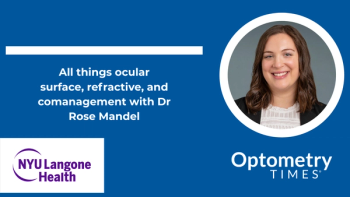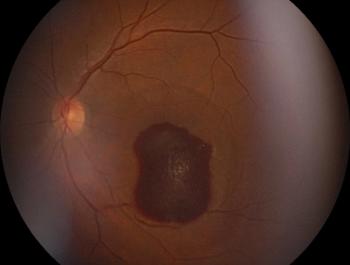
- January digital edition 2024
- Volume 16
- Issue 01
The magic of perfluorohexyloctane
By targeting tear evaporation, F6H8 ushers in a new era of dry eye treatment.
Excitement abounds with the approval of perfluorohexyloctane (Miebo; Bausch + Lomb) for the treatment of the signs and symptoms of
Some history
Fluorinated compounds have been used in clinical and biomedical applications for decades. SFAs—which are diblock molecules and do not occur naturally—are inert, colorless, nonaqueous liquids consisting of molecules with perfluorocarbon and hydrocarbon. The nomenclature of SFAs is simplified as FnHm, in which “n” and “m” describe the number of carbon atoms in the fluorocarbon and hydrocarbon chains, respectively. The newer class of semifluorinated alkanes has physiochemical properties that include high gas solubility (eg, for oxygen) and low surface tension. Due to their high propensity to assemble to interfaces, they can be used to formulate a variety of multiphase colloidal systems including emulsions, microbubbles and nanoemulsions, gels, dispersions, suspensions, and aerosols.2,3
SFAs can dissolve lipophilic drugs and, therefore, can be used as new drug excipients or drug delivery systems.4 Semifluorinated alkanes form monolayers with interesting properties at the air–water interface due to their pronounced amphi-solvophobic nature (ie, lacking an
SFAs, possessing 2 moieties of opposite character, a perfluorinated carbon and a hydrogenated fragment, also have surfactant properties (surfactants are chemical compounds that decrease the surface tension or interfacial tension between 2 liquids, a liquid and a gas, or a liquid and a solid).5
SFAs in ophthalmology
SFAs, eg, F6H8, are used in clinical ophthalmology for vitreoretinal surgery, as long-term, heavy endotamponades generally mixed with silicone oils (SOs).6 This combination may be especially beneficial in the treatment of inferior rhegmatogenous retinal detachment and proliferative vitreoretinopathy. A 2014 study investigated F6H8 use in combination with silicone oil in a series of 22 eyes with inferior rhegmatogenous retinal detachment with proliferative vitreoretinopathy, where F6H8 was used to flatten the retina and was later partially mixed with silicone oil for long-term tamponade. This combination resulted in a clear tamponade allowing postoperative visualization of the retina, with no emulsification, inflammation, or other complications. Several different combinations of F6H8/SO were used in this study—30/70, 40/60, 50/50, 60/40, and 70/30. The best results were reported with F6H8/SO ratios between 50/50 and 30/70.7
Miebo, a therapeutic drop recently approved for the treatment of evaporative dry eye, consists of 100% perfluorohexyloctane demonstrated in clinical studies to have beneficial effects for patients with evaporative DED8 and meibomian gland dysfunction.9 As 100% perfluorohexyloctane is a nonaqueous liquid, microbial growth is not possible and, therefore, it does not need a preservative.
Perfluorohexyocltane spreads rapidly across the ocular surface because of its low surface tension; it also causes minimal visual disturbances compared with gel- or ointment-based therapies because its refractive index is similar to that of water.10 Additionally, a randomized phase 3 Gobi clinical trial provided statistically significant, meaningful evidence of a reduction in signs and symptoms of DED during 8 weeks of treatment with perfluorohexyloctane compared to patients treated with saline.11 It has been proposed that F6H8 could prevent increased evaporation caused by DED by forming an occlusive layer and reducing the shear forces of the eyelid during blinking.9,10 In addition to preventing evaporation, F6H8 may facilitate heat exchange between corneal tissue and the environment, thereby reducing corneal temperature and activating TRPM8 (transient receptor potential cation channel subfamily M [melastatin] member 8), cold-thermosensitive channels of cold thermoreceptor nerves TRPM8 is also known as the cold and menthol receptor 1 (CMR1) and is a protein that is encoded by the TRPM8 gene; the TRPM8 channel is the primary molecular transducer of cold somatosensation in humans. In turn, the increased activity of corneal cold nerves leads to an increase in tearing and the blinking rate; however, it does not evoke a response of ocular discomfort.12
SFAs can also be effective as a topical drug carrier, for example, for cyclosporine and azithromycin, to the ocular surface.13,14 Advantages of SFA formulations, particularly for proteins and antibodies, include ready-to-use eye drops with improved stability at room temperature, as well as enhanced drug uptake. For the cornea, for example, the SFA suspended particles deliver high local drug concentration and increased residence time.
Other drug delivery possibilities of SFAs
SFAs hold promise for topical drug delivery to skin that is notably challenging because skin penetration is enhanced with SFAs. It is suggested that the enhancement can be explained by an increasing occlusion effect with SFA content of the nanoemulsion and, thus, the promotion of penetration into the skin.15 Occlusion reduces the evaporation of water of the skin, necessary for skin penetration, and therefore promotes penetration of active substances into the skin.16
SFAs have likewise been investigated in intravenous drug delivery, pulmonary drug delivery and protein drug delivery.17-19 The low viscosity of SFAs makes them promising options as carriers for powder suspensions.19
With their ability to carry oxygen,17 the potential for SFAs lends new possibilities to the treatment of multiple system disorders including exciting pathways for innovative drug development for maladies beyond the eye.
References
- Bausch + Lomb and Novaliq announce FDA approval of Miebo (perfluorohexyloctane ophthalmic solution) for the treatment of the signs and symptoms of dry eye disease. Novaliq. News release. May 18, 2023. Accessed October 1, 2023. https://www.novaliq.com/press-releases/2023/05/19/bausch-lomb-and-novaliq-announce-fda-approval-of-miebotm-perfluorohexyloctane-ophthalmic-solution-for-the-treatment-of-the-signs-and-symptoms-of-dry-eye-disease/
- Tsagogiorgas C, Otto M. Semifluorinated alkanes as new drug carriers—an overview of potential medical and clinical applications. Pharmaceutics. 2023;15(4):1211. doi:10.3390/pharmaceutics15041211
- Krafft MP. Fluorocarbons and fluorinated amphiphiles in drug delivery and biomedical research. Adv Drug Deliv Rev. 2001;47(2-3):209-228. doi:10.1016/s0169-409x(01)00107-7
- Meinert H, Roy T. Semifluorinated alkanes— a new class of compounds with outstanding properties for use in ophthalmology. Eur J Ophthalmol. 2000;10(3):189-197. doi:10.5301/EJO.2008.1838
- Turberg MP, Brady JE. Semifluorinated hydrocarbons: primitive surfactant molecules. J Am Chem Soc. 1988;110(23):7797–7801.doi:10.1021/ja00231a034
- Kirchhof B, Wong D, Van Meurs J, et al. Use of perfluorohexyloctane as a long-term internal tamponade agent in complicated retinal detachment surgery. Am J Ophthalmol. 2002;133(1):95-101. doi:10.1016/s0002-9394(01)01295-8
- Tosi GM, Marigliani D, Bacci T, et al. F6H8 as an intraoperative tool and F6H8/silicone oil as a postoperative tamponade in inferior retinal detachment with inferior PVR. J Ophthalmol. 2014;2014:956831. doi:10.1155/2014/956831
- Steven P, Scherer D, Krösser S, Beckert M, Cursiefen C, Kaercher T. Semifluorinated alkane eye drops for treatment of dry eye disease—a prospective, multicenter noninterventional study. J Ocul Pharmacol Ther. 2015;31(8):498-503. doi:10.1089/jop.2015.0048
- Steven P, Augustin AJ, Geerling G, et al. Semifluorinated alkane eye drops for treatment of dry eye disease due to meibomian gland disease. J Ocul Pharmacol Ther. 2017;33(9):678-685. doi:10.1089/jop.2017.0042
- Schmidl D, Bata AM, Szegedi S, et al. Influence of perfluorohexyloctane eye drops on tear film thickness in patients with mild to moderate dry eye disease: a randomized controlled clinical trial. J Ocul Pharmacol Ther. 2020;36(3):154-161. doi:10.1089/jop.2019.0092
- Tauber J, Berdy GJ, Wirta DL, Krösser S, Vittitow JL; GOBI Study Group. NOV03 for dry eye disease associated with meibomian gland dysfunction: results of the randomized phase 3 GOBI study. Ophthalmology. 2023;130(5):516-524. doi:10.1016/j.ophtha.2022.12.021
- Delicado-Miralles M, Velasco E, Díaz-Tahoces A, Gallar J, Acosta MC, Aracil-Marco A. Deciphering the action of perfluorohexyloctane eye drops to reduce ocular discomfort and pain. Front Med (Lausanne). 2021;8:709712. doi:10.3389/fmed.2021.709712
- Gehlsen U, Braun T, Notara M, Krösser S, Steven P. A semifluorinated alkane (F4H5) as novel carrier for cyclosporine A: a promising therapeutic and prophylactic option for topical treatment of dry eye. Graefes Arch Clin Exp Ophthalmol. 2017;255(4):767-775. doi:10.1007/s00417-016-3572-y
- Agarwal P, Craig JP, Krösser S, Eickhoff K, Swift S, Rupenthal ID. Topical semifluorinated alkane-based azithromycin suspension for the management of ocular infections. Eur J Pharm Biopharm. 2019;142:83-91. doi:10.1016/j.ejpb.2019.06.008
- Binder L, Jatschka J, Kulovits EM, Seeböck S, Kählig H, Valenta C. Simultaneous penetration monitoring of oil component and active drug from fluorinated nanoemulsions. Int J Pharm. 2018;552(1-2):312–318. doi:10.1016/j.ijpharm.2018.10.012
- Wissing S, Müller R. The influence of the crystallinity of lipid nanoparticles on their occlusive properties. Int J Pharm. 2002;242(1-2):377-379. doi:10.1016/s0378-5173(02)00220-x
- Seiffge DJ, Lapina NE, Tsagogiorgas C, Theisinger B, Henning RH, Schilling L. Improvement of oxygen supply by an artificial carrier in combination with normobaric oxygenation decreases the volume of tissue hypoxia and tissue damage from transient focal cerebral ischemia. Exp Neurol. 2012;237(1):18-25. doi:10.1016/j.espneurol.2012.06.007
- Tsagogiorgas C, Jung T, Krebs J, et al. Aerosolized semifluorinated alkanes as excipients are suitable for inhalative drug delivery—a pilot study. Int J Pharm. 2012;422(1-2):194-201. doi:10.1016/j.ijpharm.2011.10.051
- Günther B, Theisinger B, Theisinger S, et al, inventors. Novaliq GMBH, assignee. Stabilised protein compositions based on semifluorinated alkanes. US Patent 9,757,460. September 12, 2017.
Articles in this issue
almost 2 years ago
Diagnosing and treating Demodex blepharitisalmost 2 years ago
Why is contrast sensitivity important?almost 2 years ago
What’s your clinical protocol for managing diabetic retinopathy?almost 2 years ago
Looking forward to improving and lessening the allergic responsealmost 2 years ago
Advancing multifocal contact lens design with biometryalmost 2 years ago
Cut out the cigarettes for the sake of the optic nerveNewsletter
Want more insights like this? Subscribe to Optometry Times and get clinical pearls and practice tips delivered straight to your inbox.




















































.png)


